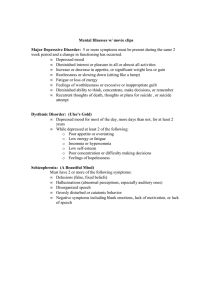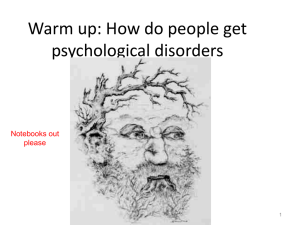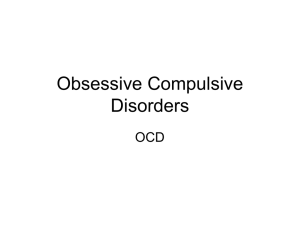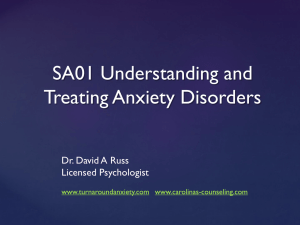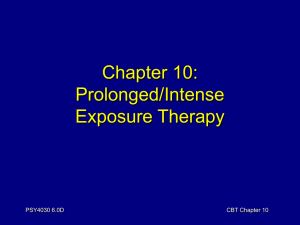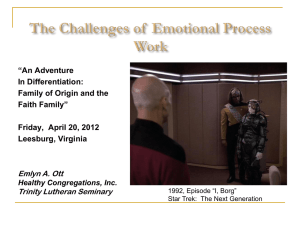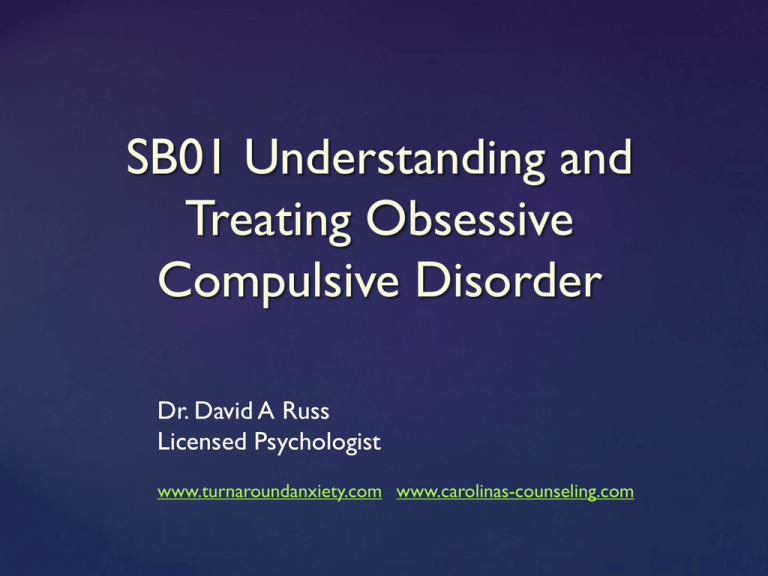
SB01 Understanding and
Treating Obsessive
Compulsive Disorder
Dr. David A Russ
Licensed Psychologist
www.turnaroundanxiety.com www.carolinas-counseling.com
Notes and Powerpoint can be
downloaded from:
www.turnaroundanxiety.com/documents
1.
2.
3.
4.
5.
6.
Definition
How OCD Functions
Variations
Components of Treatment
Example of Treatment
Question and Answer
Outline for this Workshop
•
•
Obsessions
• thoughts that demand focus in spite of
and contrary to desire of person.
• Thoughts cannot be suppressed even
though not characteristic of self.
• Goes after deep value
Compulsions
• urges to act or think to reduce
anxiety/danger
• Avoid or fix danger
Definition
Functional Description
•
•
Obsessions cause anxiety/distress
to rise
Compulsions cause
anxiety/distress to decrease
How it works - Function
Two Parts of Obsessions
•
Triggers (actually present “What is”)
•
•
Ex. red stain on table
Core Fear (imagined consequence
“What if?”)
•
Ex. I will be contaminated by virus and
die
How it works - Obsession
Two Forms of Triggers
•
External
•
•
Contaminate, homework, broken glass
Internal
•
Violent thought about child, perverted
sexual thought
How it works - Obsession
Two Kinds of Compulsions
•
Behavior
•
•
Ex. washing, touching, confessing,
repeating, reassurance-seeking
Cognitive
•
Counting, undoing, replacing, praying,
figuring it out, remembering
How it works - Compulsion
Purpose of Compulsion is
escape/prevent/repair – Avoidant
Coping
•
Primary
•
•
Avoid, don’t go there, leave
Secondary
•
If can’t avoid then make it “safer”
How it works - Compulsion
Trigger
Primary safety
Secondary safety
Buying a soft drink
Don’t buy it
Check the top, pick
something from the back,
examine for imperfection
Stop light
Don’t drive
Stare at light, say it out
loud, return, call police &
ask about accidents
Thought of bad thing
occurring
Never think of bad things Check that everything is
okay, ask for reassurance,
replace thought with
good one
Thought that maybe you
said something offensive
Avoid conversations
Check non-verbals, hold
mouth closed, check
back to see, apologize
How it works - Compulsion
Reinforcing Cycle
Trigger
Obsessions
Compulsions
Anxiety
Decrease
View as
Threat Core Fear
Avoidant
Coping
Anxiety
Increase
How it works
•
•
•
Contamination
Symmetry/Perfection
Taboo (mistakenly called Pure “O”)
•
•
•
•
•
•
Aggression
Sex
Religious (Scrupulosity)
Calamity/Harm
Bad Luck
Health and Body
Variations - Obsessions
•
•
•
•
•
•
•
•
•
Decontaminate/Clean
Checking
Counting
Undoing
Perfection
Touching or movement
Mental
Prevention/Protect
Body Focused
Variations - Compulsions
•
•
Medical
CBT
•
•
Cognitive (C part of CBT)
Exposure and Response Prevention
(ERP) (B part of CBT)
Treatment
•
•
•
•
Educate about Disorder
Motivation
Assess and Personalize
Develop process to disprove fear
•
•
•
Cognitive Restructuring
ERP
Maintain, Prevent relapse
Treatment Process
Common Cognitive Distortions
•
•
•
•
•
•
•
Intolerance of Uncertainty
Over-estimate responsibility
Believe thoughts are too significant
Intolerance of distress
Things have to be just right
Fear of positive or relief
Martyrdom
Treatment - Cognitive
ERP
• Exposure
•
•
•
Deliberately evoking anxiety
Remaining in distress
Response Prevention
•
•
•
Prevent normal coping response
Not doing anything to reduce distress
before, during and after exposure
Don’t employ Safety Behaviors
Treatment - ERP
Exposure
• Types
•
•
•
•
•
Thought
Interoceptive
Virtual
In situation
Create Hierarchy
•
•
•
•
SUDs
List of triggers and core fears
Put in 3 categories - Easy, Medium, Hard
Create an exposure for them
Treatment - Exposure
Exposure Process
1.
2.
3.
4.
5.
6.
7.
8.
9.
10.
Planned and structured
Gradual
Prepare to be anxious
Don’t fight the feelings
No safety behaviors
Test negative predictions
Keep Track of Fear Level
Make it last until level drops
Repeat frequently
Practice by yourself
Treatment - Exposure
Abramowitz, Jonathan S. (2012-06-25). Obsessive Compulsive Disorder (Advances in Psychotherapy; Evidence-Based
Practice) (Kindle Locations 2630-2652). Hogrefe Publishing (com). Kindle Edition.
Challenge
Trigger
Exposure
Low (SUDs 1-3)
Think bad word – core
fear of harm
List bad words and say
them over and over
Things are out of place – Mess up order, have
core fear something bad family member mess up
will result
room and not fix
Medium (4-6)
Conversation and core
Tell a lie, say something
fear that might say
offensive, give wrong
something to cause harm information, made list of
yes, no questions and
she was to answer
wrong
High (7-10)
Exposure to odd
numbers – core was bad
luck
Example
Post odd numbers
around house, put tv on
odd volume, chew wrong
# of times
Trigger
Exposure
Response Prevention
Think bad word – core List bad words and say
fear of harm
them over and over
Say out loud, don’t
confess or undo
Things are out of place Mess up order, have family
– core fear something member mess up room
bad will result
and not fix
Look at mess, don’t fix
later, don’t balance with
something else, go in
room
Conversation and core
fear that might say
something to cause
harm
Tell a lie, say something
offensive, give wrong
information, made list of
yes, no questions and she
was to answer wrong
Don’t apologize, fix it
later, non-verbal undoing
Exposure to odd
numbers – core was
bad luck
Post odd numbers around
house, put tv on odd
volume, chew wrong # of
times
Don’t change in mind,
don’t avoid looking, don’t
do something else
physical even #
Example with RP
Break Cycle by
disproving fear
Trigger
Cognitive
Obsessions
Anxiety
Decrease
Tolerance
View as
Threat Core Fear
Avoidant
Coping
Anxiety
Increase
Decrease
ERP
Compulsions
Purpose of CBT
Turnaround
www.turnaroundanxiety.com

